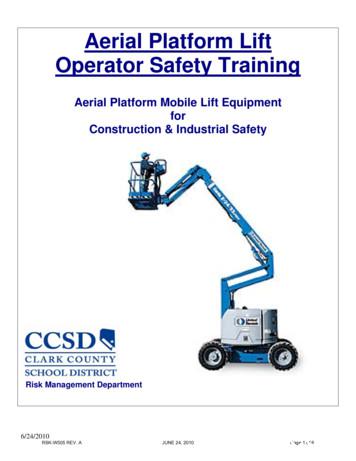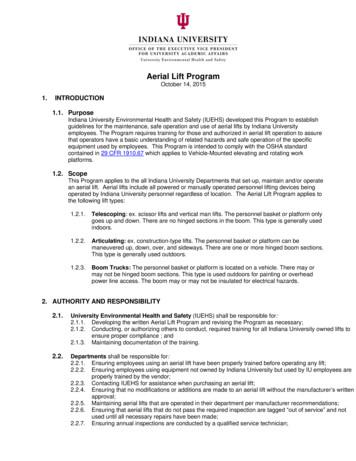Aerial Driver Manual; Elevator Emergencies
ElevatorsIntroductionThe intent of this manual is to provide information needed to safely andefficiently deal with elevator emergencies. This section includes but is not limited toelevator knowledge and inspection, general operation and safety features. The missionof elevator rescue is to safely remove occupants from an elevator that has malfunctionedand stopped in the hoistway while maintaining the safety and welfare of the occupantsand fire/rescue personnel.TerminologyMachine Room: Normally found on roof of structure above the hoistway if a Tractionelevator. The main disconnect for the system is found in the Machine Room. If theelevator is Hydraulic, the Machine Room will be found on the lower level near the elevator.Hoistway:elevator.May also be known as the Shaft. The vertical opening that encloses theCar: The passenger enclosure.Landing Entrance: The elevator doors located on each floor of the structure. Thisprovides the access for use of the keys or pole.Pit: The bottom portion of the hoistway. Contains numerous moving parts.Elevator TypesThere are two types of elevators, hydraulic and traction. Hydraulic elevators havea motor-driven pump, a hydraulic cylinder and a fluid reservoir. Pressure is put on thecylinder and the car is raised. Gravity lowers the car back to the lowest floor. Tractionelevators have a hoisting machine, ropes/cables and a counterweight. Traction isachieved by friction on the driving sheave, which in turn raises and lowers the car.The traction elevator can either use a geared or gearless traction machine.Regardless of the type it will have a governor, controller and machine disconnect switch.MCFRS Driver Certification ProgramPage 1 of 11Aerial - Module 12
Drive SheaveDrive MotorBrake AssemblyGeared Traction MachineElevator GovernorPull Handle Down to Shut off PowerMCFRS Driver Certification ProgramPage 2 of 11Aerial - Module 12
Hoisting ropes are wire cables designed specifically for elevator use. The ropesare designed to carry not only the weight of the car but the live load within the car. Multipleropes may be used to increase traction. Redundant ropes provide a safety factor for thecar. The ropes are all oily and can have burrs on them. Gloves must be used whenfunctioning with the ropes.Counterweights are specifically designed weights on the opposite ends of thehoisting rope from the car. The counterweight equals the cars’ total dead weight plus40% of the cars’ designed live loadCounterweightLock-out/tag-out is the process of locking/removing power from the machine anddeclaring a safe work area.MCFRS Driver Certification ProgramPage 3 of 11Aerial - Module 12
Elevator Car RescueIf a patient needs to be rescued from a car that is not in working order, access to the carwill need to be made. This access can be made in one of three ways. First, using theelevator keys, disengage the door interlock mechanism. Second, use an elevator pole todisengage the door locking mechanism. If neither of the first two options work, usestandard forcible entry tools to break and remove the doors.When beginning any elevator rescue, locate the car and contact the occupants. Checkthe fireman’s’ service first to see if the car will move. Attempt to use the keys and poleprior to using forcible entry. Finally, remember to ALWAYS protect the hoistway.Only remove patients from a non-working elevator if it is safe to do so. Remember tofollow all standard safety policies. Perform Lock-out/Tag-Out. Remember to stay withinthe hoistway of the rescue operation. Prior to performing the rescue, determine whichexit will be safest for both the occupants and the rescuers: car top, side exit, through thedoors. Do not have any more than two rescuers on top of the elevator car.Important: Always follow Lock-Out/Tag-Outprocedures for the main power disconnect prior toentering an elevator hoistway for rescue.Fireman’s or Firefighter’s ServiceThe Fireman’s Service button is activated by utilizing the key switch in the lobby of thebuilding. Once the key has been turned to the On position, the elevators will all come tothe lobby and park with the doors open. This function will only work if the elevator isactivated. Phase 1 of this function is completed when the elevator is in the lobby or atthe desired floor. This will prohibit residents from utilizing the elevator during anemergency. Below is a picture of the fireman’s service button found in the lobby of abuilding.MCFRS Driver Certification ProgramPage 4 of 11Aerial - Module 12
Once inside the elevator, observe the fireman’s service button. If lit, the elevator is infireman’s control. By accessing the key switch inside the elevator, Phase 2 of the elevatorcontrol begins and the fire department will have control of the elevator. Test the dooropen/close buttons to make sure that they still work. This will prevent the elevator fromstopping at the wrong floor. Remember to stop the elevator several floors below thereported fire.MCFRS Driver Certification ProgramPage 5 of 11Aerial - Module 12
Elevator KeysBelow are examples of various elevator keys used to access the hoistway doors.HookDrop KeyPickDouble Drop KeyT-KeyHalf-Moon KeyDrop KeyInsert the appropriate key through the hole on the front of the car door until the tip drops.MCFRS Driver Certification ProgramPage 6 of 11Aerial - Module 12
Once the key drops through the backside of the car door, turn the key until it catches onthe pick-up roller arm. Continue to turn key until car door opens.Poling the ElevatorIf poling the elevator is necessary, use the hook andaccess from the closest door using the appropriateelevator key. Using the pole, unlock the hoistway doorabove. Additional personnel stationed at the elevatorabove will open up those doors, pull up the pole andutilize that pole to open the door above.MCFRS Driver Certification ProgramPage 7 of 11Aerial - Module 12
Hoistwaydoorsprovideprotection for the hoistwayopening. They may be singlespeed or two speed horizontal,bi-parting vertical, or swinging.Swinging doors are normallyfound on residential elevators.The doors operator will open thecar doors which will then allowaccess to the passengers. Thecar doors are the only doors thatare powered.Moving this armunlocks thehoistway doorsThis is directed withthe elevator poleDoor OperatorCar TopMCFRS Driver Certification ProgramPage 8 of 11Aerial - Module 12
Emergency Hatch AccessIf access through the door of the nonworking car is not available, use thecartop of the adjacent car for yourinspection. To move the working car inline with the stuck car, have a rescuerenter the working car. The rescuer thentakes the working car down below thestalled car. Open the hoistway door of theworking car and locate the car topinspection station. On the inspectionstation, move the stop switch to Off andthe Inspection/Automatic switch toInspection.Hatch Lifts UpHave the rescuer exit the working and then close the doors using the wheel on the dooroperator. Close the hoistway doors and while standing in the middle of the car top, pushthe direction button to move the elevator into position next to the stalled car. Open theemergency hatch of the stalled car, and, using a folding ladder, rescue any trappedindividuals.MCFRS Driver Certification ProgramPage 9 of 11Aerial - Module 12
MCFRS Driver Certification ProgramPage 10 of 11Aerial - Module 12
Steps for Elevator Rescue1. Locate the elevator in the hoistway. Check the position indicators and relay toofficer.2. Determine if any medical emergencies exist inside the stalled elevator.3. Lockout/Tagout main line disconnect in machine room.4. Determine what is best access for rescue.5. Open hoistway doors using elevator keys or by poling the elevator. Open the cardoors – use the door operator if necessary.6. If no access to the doors is available, use the adjacent elevator to access the cartop.7. Do not place too many people on top of the working elevator when performing arescue. Move them to the nearest hoistway door for exit.Hydraulic Elevator Emergency AccessIf a hydraulic elevator is stuck between the floors, you may have to manually lowerthe elevator in order to perform a rescue.ManualLowering ValveCar TopFirst, using lock-out/tag-out, ensure that the power has been shut off and place afirefighter at the lower hoistway opening with the doors open. Open the valve at the topof the car until the elevator moves. When the car reaches the same level as that of thefirefighter at the lower hoistway, close the valve. This will stop the elevator and allowaccess for the rescue.Elevator FiresIf an elevator has had significant fire damage, do not get on or into the elevator.Extinguish the fire using long hooks to remove any debris. If the cables have beenexposed to high heat, they may fail causing the elevator to drop into the pit.MCFRS Driver Certification ProgramPage 11 of 11Aerial - Module 12
Once inside the elevator, observe the fireman’s service button. If lit, the elevator is in fireman’s control. By accessing the key switch inside the elevator, Phase 2 of the elevator control begins and the fire department will have control of the
The Elvoron Stella is a luxury residential elevator with sliding elevator doors. it utilizes the same drive and control systems as a Lu/LA (limited use, limited ap-plication) commercial elevator. A Lu/LA elevator is a power passenger elevator. The use of these products is limited
18-V-189 NCCD-Claremont Properties, LLC Elevator GRANT 18-V-190 1950 Addison Apartment Joint Venture, LLC Elevator GRANT 18-V-191 3400 Sunset LLC Elevator GRANT 18-V-192 Sutter Medical Center Elevator GRANT 18-V-193 Chalmers Investment LLC Elevator GRANT 18-V-197 1716 Lofts, LLC Elevator GRANT
meets the elevator code standards existing at the time the elevator was installed. V. F. "Substantial Alteration" shall means any alteration to a elevator covered by these . W. "Temporary Elevator Mechanic License" means a license issued by the state elevator. inspector to an individual, not currently licensed as an elevator mechanic, who meets
PG 18-10 – ELEVATOR DESIGN MANUAL October 1, 2020 . 1 . 1.0 GENERAL REQUIREMENTS . A. An elevator machine room shall be provided for each individual elevator or group of elevators. The elevator drive machine and elevator controller shall be in the same code approved machine room. B.
Aerial Platform Lift Operator Safety Training Aerial Platform Mobile Lift Equipment for Construction & Industrial Safety Risk Management Department 6/24/2010 RSK-W505 REV. A JUNE 24, 2010 Page 1 of 6. QUICK CARD TM Aerial Lifts Safety Tips Aerial lifts
Aerial Lift Safety Program. Provide specific operational training for each aerial lift. Observe the operation of aerial lifts, and correct unsafe practices. 6.3 Operators Read the Aerial Lift Safety Program. Complete the Daily Pre-Use Inspection Che
Prior to operating an aerial lift, the employee shall perform a pre-operation safety inspection as follows using the appropriate Aerial Lift Inspection Checklist in Appendix B. 3.2.1. The inspection must be made daily or when the aerial lift is used; 3.2.2. When aerial lifts are used on a r
Bob Gardner, Developer Technology Engineer 24th September 2012. Title: Multicore Architecture of PowerVR Author: Bob Gardner Created Date: 9/25/2012 7:02:01 AM .























